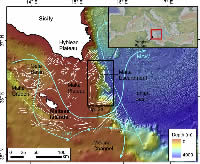Outer shelf seafloor geomorphology along a carbonate escarpment: The eastern Malta Plateau, Mediterranean Sea
Micallef A., A. Georgiopouloub, J. Mountjoy, V.A.I. Huvenne, C. Lo Iacono, T. Le Bas, P. Del Carlo, D. Cunarro Otero
Continental Shelf Research, 131, 12-27, http://dx.doi.org/10.1016/j.csr.2016.11.002.
Abstract
Submarine carbonate escarpments, documented in numerous sites around the world, consist of thick exposures of Mesozoic shallow water carbonate sequences – primarily limestones and dolomites – with reliefs of >1 km and slope gradients of >70°. Whilst most research efforts have focused on the processes that shaped carbonate escarpments into complex and extreme terrains, little attention has been paid to the geomorphology of shelves upslope of carbonate escarpments. In this study we investigate high resolution geophysical, sedimentological and visual data acquired from the eastern Malta Plateau, central Mediterranean Sea, to demonstrate that the outer shelf of a carbonate escarpment is directly influenced by escarpment-forming processes. We document forty eight erosional scars, six long channels and numerous smaller-scale channels, three elongate mounds, and an elongate ridge across the eastern Malta Plateau. By analysing their morphology, seismic character, and sedimentological properties, we infer that the seafloor of the eastern Malta Plateau has been modified by three key processes: (i) Mass movements – in the form of translational slides, spreading and debris flows – that mobilised stratified Plio-Pleistocene hemipelagic mud along the shelf break and that were likely triggered by seismicity and loss of support due to canyon erosion across the upper Malta Escarpment; (ii) NNW-SSE trending sinistral strike-slip deformation in Cenozoic carbonates – resulting from the development of a mega-hinge fault system along the Malta Escarpment since the Late Mesozoic, and SE-NW directed horizontal shortening since the Late Miocene – which gave rise to NW-SE oriented extensional grabens and a NNW-SSE horst; (iii) Flow of bottom currents perpendicular and parallel to the Malta Escarpment, associated with either Modified Atlantic Water flows during sea level lowstands and/or Levantine Intermediate Water flows at present, which was responsible for sediment erosion and deposition in the form of channels and contouritic drifts.
http://www.sciencedirect.com/science/article/pii/S0278434316303922


